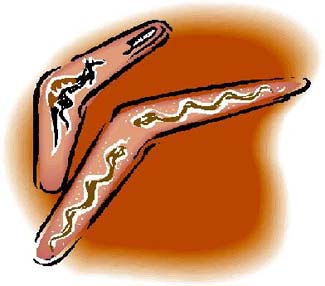 Have you ever tried to throw a boomerang? Did you get it to come back to you?
Have you ever tried to throw a boomerang? Did you get it to come back to you?  Have you ever tried to throw a boomerang? Did you get it to come back to you?
Have you ever tried to throw a boomerang? Did you get it to come back to you?
The Return of the Boomerang
Nothing says "Summer is here!" quite like the smack of a baseball as it is caught in a baseball glove. But what if no one is available to play catch? Then maybe it's time to trade in the baseball and glove for a boomerang.
Over the past decade boomeranging has become increasingly popular. All over the world, this activity is capturing the interest of young and old. Even those who have seen a boomerang still marvel that a curved stick can circle back to the person who threw it.

History of the Boomerang
Boomerangs have been around for thousands of years. Many peoples, including the ancient Egyptians, the people of southern India, and the Hopi Indians, used throwing sticks that were similar to boomerangs. But it was the natives of Australia, known as Aborigines, who developed the amazing returning version. The Aborigines used boomerangs for hunting and as digging tools.
Note the heading above. Headings help readers organize information.

The Flight of the Boomerang
It wasn't until the mid-1800s that people began to study the scientific principles behind boomerang flight. Perhaps one reason it took so long to understand the science of boomerangs is that not all boomerangs fly in exactly the same way. Because early boomerangs were made by hand, it was virtually impossible to produce two boomerangs with exactly the same wing surface.
1. The first of these principles is that the shape and curve of a boomerang produce lift . Much like airplane wings, a boomerang is flat on one side and curved on the other. As air flows over the slope of the curved surface of the boomerang's wing, it forces the curved edge upward. At the same time, the air flowing under the wing's flat surface pushes it up from the bottom. The result of these forces is lift. Thus, the principles of aerodynamics can be applied to the boomerang to help understand its flight.
2. The second factor affecting the boomerang's ability to return is that it spins like a gyroscope. A good example of a gyroscope is a toy top. Tops are easily set to spinning, but once spinning, they are very hard to move. In fact, if pushed while spinning, a gyroscope will twist at a right angle from the direction in which it was pushed. For instance, a spinning top pushed to the north will actually tilt to the east.

Follow the path of a thrown boomerang in the diagram above.
When a boomerang is thrown, the force of the lift causes it to turn toward one side rather than straight up. As it spins and moves forward, air flows faster over the top surface of the boomerang and gives it more lift. This extra lift tries to twist the boomerang off course. Since it is spinning very fast, the boomerang begins turning away from the twisting force. As a result it arcs back to its thrower with relative exactitude.
Just because a well-designed boomerang can return nearly to its point of origin does not mean that it automatically does so. Learning to throw a boomerang so that it will return is a challenge.
Catching a boomerang spinning at speeds of up to 60 miles per hour takes even more practice. For anyone who masters the art of throwing and catching a boomerang, playing catch with a baseball may have forever lost its thrill.
Nothing says "Summer is here!" quite like the smack of a baseball as it is caught in a baseball glove. But what if no one is available to play catch? Then maybe it's time to trade in the baseball and glove for a boomerang.